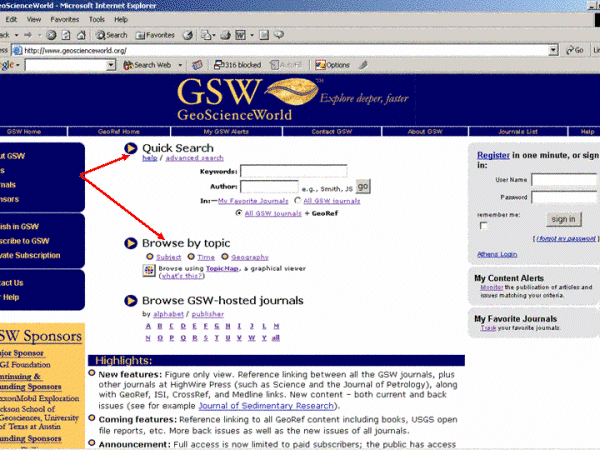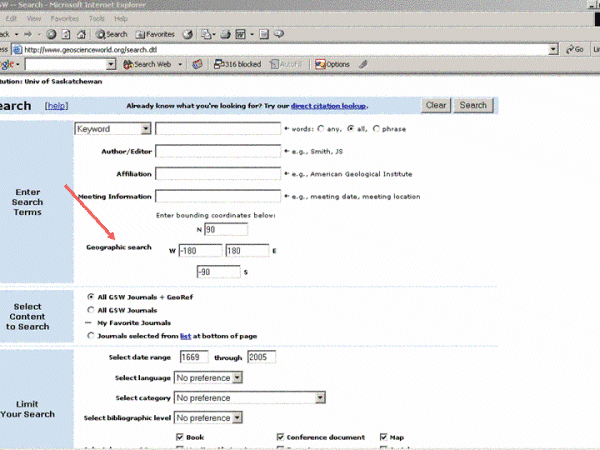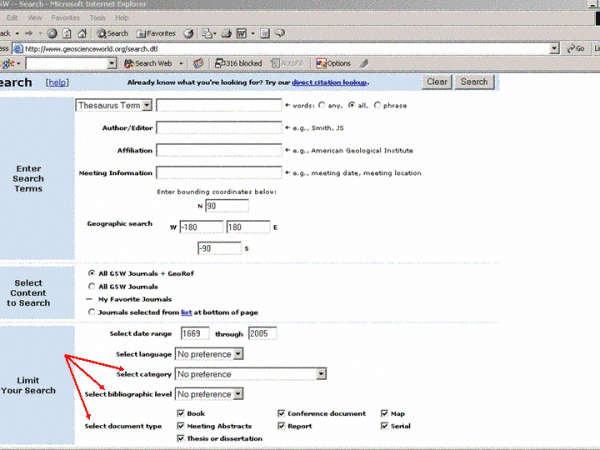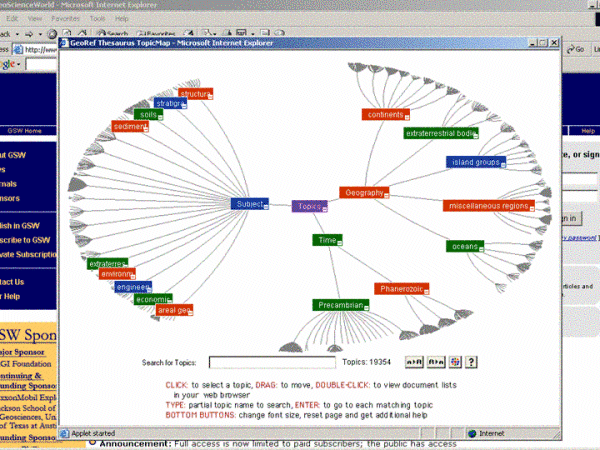| URLs in this document have been updated. Links enclosed in {curly brackets} have been changed. If a replacement link was located, the new URL was added and the link is active; if a new site could not be identified, the broken link was removed. |
Database Reviews and Reports
GeoscienceWorld Millennium Collection -- A New Resource in the Earth Sciences
Yelena Pancheshnikov
Agriculture, Biology, Geography and Environmental Sciences Librarian
University of Saskatchewan Libraries
yelena.pancheshnikov@usask.ca
GeoscienceWorld Millennium Collection {http://www.csa.com/factsheets/gsw.php} is a new collection of full-text peer-reviewed journals in the earth sciences that is fully interoperable with GeoRef and delivered through Stanford University HighWire Press Internet platform. The vendor for the collection is Cambridge Scientific Abstracts.
GeoscienceWorld Millennium Collection is developed by the GeoscienceWorld. The latter is a nonprofit corporation formed in 2004 by six leading earth sciences societies and one institute (Geological Society of America, the Mineralogical Society of America, American Association of Petroleum Geologists, Society of Exploration Geophysicists, Society for Sedimentary Geology and the Geological Society of London, and the American Geological Institute) for the purpose of making information in the geosciences easily and economically available through the Internet. The founding organizations represent over 100,000 scientists engaged in basic and applied research and education in all of the major areas of the earth sciences.
GeoscienceWorld produces two related databases: GeoscienceWorld Millennium Collection and the GeoscienceWorld Literature Archives. A subscription to the Millennium Collection also provides access to the Literature Archives at no additional cost.
The GeoScienceWorld Millennium Collection includes the full text of 30 peer-reviewed journals published by the founding organizations, as well as by some other nonprofit and independent geoscience publishers from six countries. Prior to becoming part of the collections some of these journals were available only in print. The list of journals includes major periodicals in the field that are ranked highly by the ISI impact factor. All of the currently included journals have a minimum of a one-year archive, but many start with the year 2000. The GeoscienceWorld Literature Archives include complete back files of the same journals starting in 1999 or earlier. For 13 of the 30 journals, back files start much earlier. The Bulletin of the Seismological Society of America goes back to 1911, the Journal of Sedimentary Research goes back to 1931, and Micropaleontology goes back to 1954.
The scope of the collection will be expanded by increasing the number of journals, including other material types such as maps and books, as well as publications in languages other than English. It is expected that in 2005 another six journals will be added to the existing collection of 30.
Searching the Collection
The collection can be searched, or browsed (Figure 1). Searching can be done by keyword or a thesaurus term, as well as by a few other standard fields in the bibliographic record.

Figure 1
A new feature is searching by bounding coordinates that allows the searcher to specify the longitude and the latitude of the area of interest (Figure 2)

Figure 2
Limiting can be done in a couple of standard ways, as well as by subject category, bibliographic level and document type (Figure 3). Subject categories are very broad areas of geology, such as paleobotany, seismology, and stratigraphy. From a librarian's point of view, subject categories should be used as a way of searching, ideally in combination with keyword and thesaurus based searching, and not as a way of setting limits. The final results, however, do not depend upon the location of this feature. Limiting by bibliographic level provides four options: analytic, collective, monographic, and serial. Limiting by document type includes standard material types, among which are books and serials. The overlap is unnecessary and the categories may not always be clear to the users.

Figure 3
Browsing can be done by subject, topic, or time both in the text format and through a topic map (Figure 4). The latter is a wonderful feature of the collection that will most likely become a preferred way of accessing the database by beginners in the field, as well as by younger users who are often attracted by visual components of databases.

Figure 4
Additional Research Features
Several types of e-mail alerts, including a table of contents service are available by subscription. As in most of the bibliographic tools of this kind references can be downloaded to citation management software including EndNote, ProCite, and Reference Manger.
Pricing
Pricing is based on the total number of geoscience faculty and research staff and is categorized into 5 tiers. It varies significantly from less than $3,000 to over $15,000. 10-15% discounts are offered to library consortia.Conclusions
The major value of the collection is its content -- the full text of 30 high-impact peer-reviewed journals and the expected growth of the current collection. The other important feature is its functionality: direct linkage to GeoRef, all of the GSW Collection journals, as well as to any other journals available through other subscriptions, and the ISI citation indexes through the Web of Science.
The new resource will be an exceptionally valuable addition to the collection
of any university library that supports teaching and research in the earth
sciences.
| Previous | Contents | Next |
